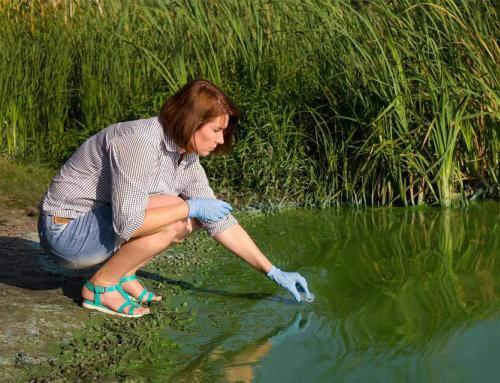LOW OXYGEN AND POND AERATION
William A. Wurts, State Specialist for Aquaculture
Kentucky State University Cooperative Extension Program
www.ca.uky.edu/wkrec/Wurtspage.htm
 Water can only hold a limited amount of oxygen. That is determined by atmospheric pressure, temperature and salinity. In a natural setting, oxygen is added to water by atmospheric diffusion at the surface, by wind circulation (augmented surface diffusion) and by photosynthesis (oxygen produced by phytoplankton or algae).
Water can only hold a limited amount of oxygen. That is determined by atmospheric pressure, temperature and salinity. In a natural setting, oxygen is added to water by atmospheric diffusion at the surface, by wind circulation (augmented surface diffusion) and by photosynthesis (oxygen produced by phytoplankton or algae).
Photosynthesis accounts for most of the oxygen in water. The oxygen content of water increases with increasing atmospheric pressure and decreasing temperature and salinity. The amount of oxygen in water is measured as milligrams per liter(mg/l) dissolved oxygen (DO).
Oxygen Depletion
A number of conditions may develop which result in oxygen depletion, DO at levels insufficient (less than 3 mg/l) to support aquatic life (e.g. fish).
Oxygen Depletion in Ponds Are Typically associated with:
1. Hot, cloudy, still weather is common from the end of July to the beginning of September. High water temperature (86oF or greater) reduces oxygen holding capacity. Cloud cover limits available light, slowing or halting photosynthetic oxygen production. No wind stops pond circulation and restricts surface diffusion of atmospheric oxygen. Warm water increases fish consumption of oxygen by accelerating their metabolic rate. Fish are ectotherms (cold blooded); therefore, body temperature and activities are regulated by water temperature. Fish biomass (total weight in pond) and oxygen needs are usually greatest during the hot months of late summer.
2. Sudden death of phytoplankton or algal bloom, “bloom crash,” may result from insufficient light (e.g. cloud cover) for photosynthesis, inadequate pond nutrients (a bloom too dense to be supported by available nutrients and oxygen) and/or bloom senescence (the plant cell line becomes too old to continue reproduction). Oxygen is consumed or depleted when dead phytoplankton/algae decay. During the nighttime hours, a dense phytoplankton bloom can remove all oxygen from the water for respiration (to breathe) alone. When a bloom crash occurs, the water appears to have become “black” or clear overnight.
3. Pond stratification or turnover. During summer months in deep ponds (8 feet or greater), the upper 4-6 feet of the water column warms quickly and becomes less dense or lighter than deep water. Because the upper layer is warmer and lighter, it does not mix with the cool, deep water. The cool water near the bottom becomes stagnant; oxygen is depleted and toxic compounds may be produced by bacteria and decaying organic matter. The deep layer remains unoxygenated (anoxic) because of stratification (layering). A sudden, heavy rain (2-3 inches or greater) or a strong cold front (“Blue Norther”) can rapidly cool and/or mix (wind turbulence) the upper layer. The now cooler or circulating upper layer sinks or mixes and causes the deep anoxic layer to rise above or combine with the surface water. That depletes or reduces oxygen in upper waters where fish are being cultured.
Read more: Identifying, Treating and Managing harmful algae blooms.


